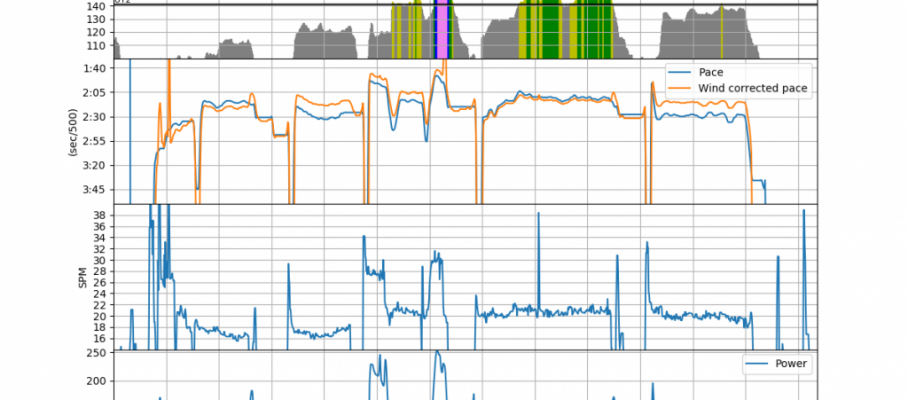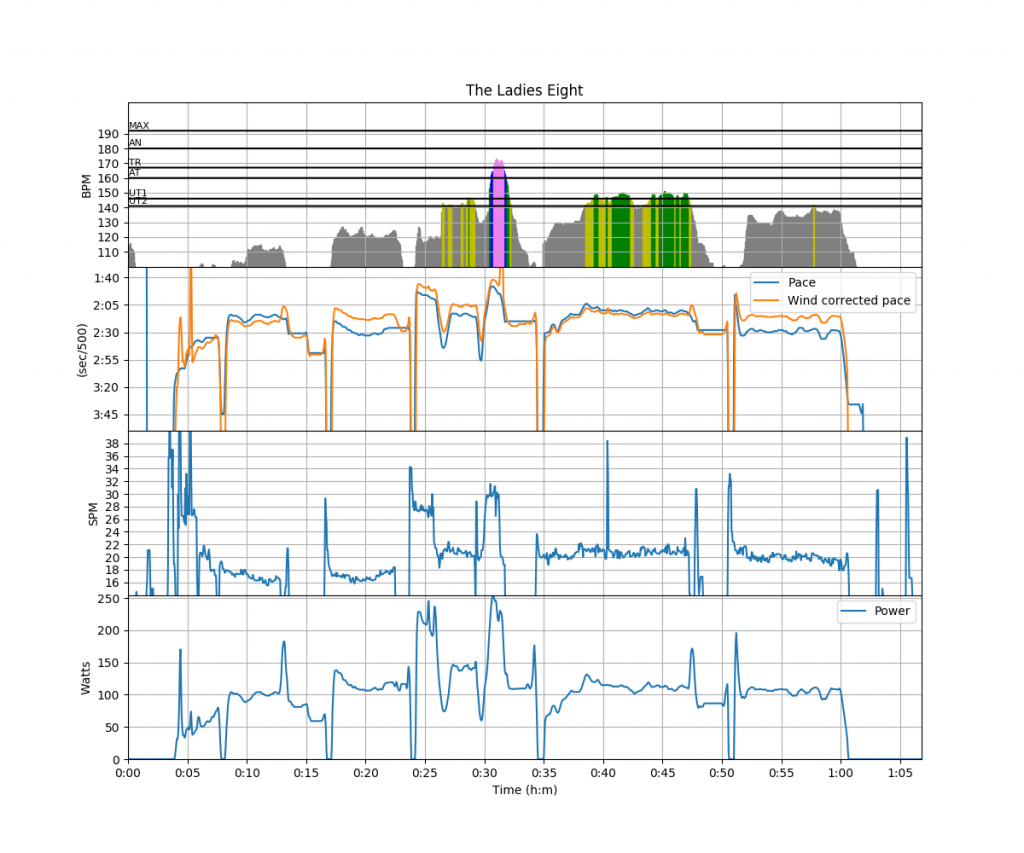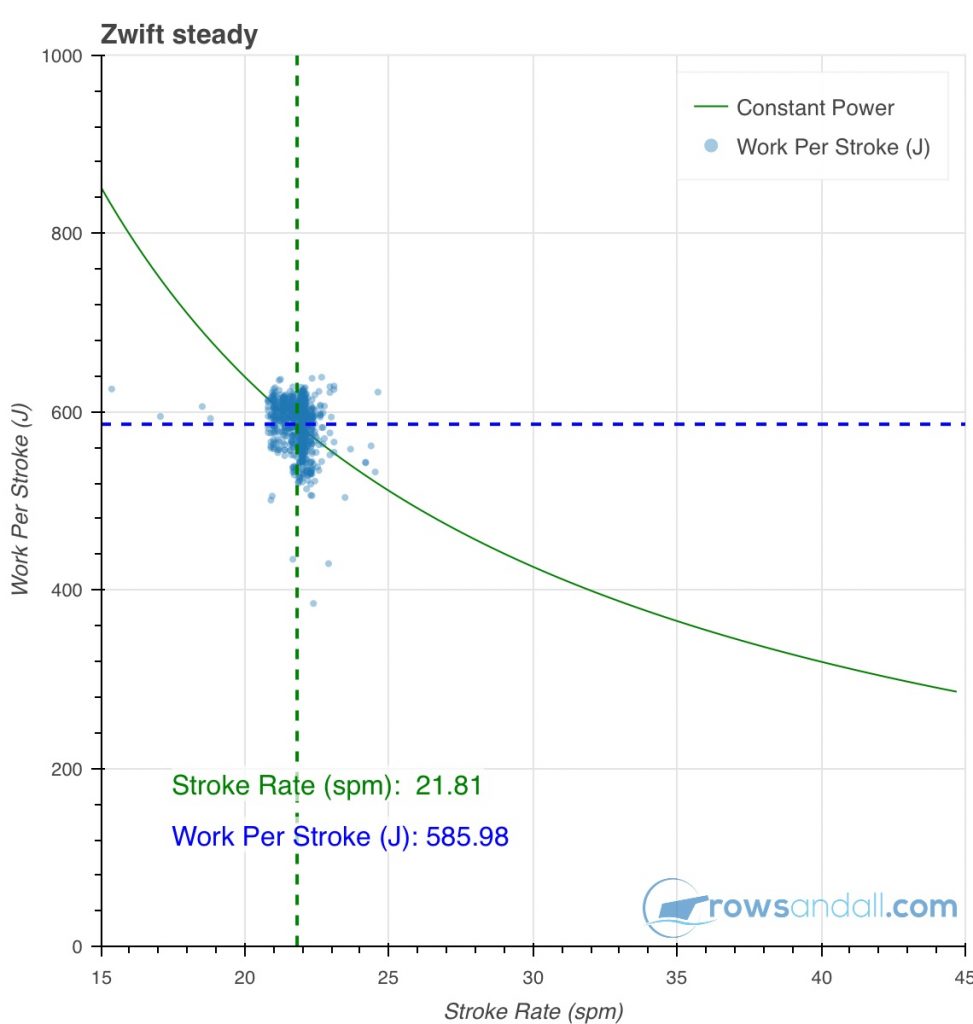May 6 2018
Saturday – Steady State and RiM test
Interesting conditions. When we arrived, the lake was pretty choppy, but it calmed down while I prepared to row. Then, during the row, the chop became gradually worse. I actually enjoyed it and tried to row stably in all conditions.
I was also test driving RiM (Rowing in Motion) on Android. RiM is an app developed by Johannes Rudolph. RiM measures boat acceleration and allows you to analyze the dynamics and efficiency of your boat. The last time I used this app was in September 2015, so we have two entire seasons between data collection. Here’s a chart:

And here are is another chart, looking also at 30spm:
The legend:
And some metrics:
Interesting that the Catch Slope (for the 30/31spm strokes) has become less steep over the two years, but the catch duration has shortened. The catch duration is the time during which the boat decelerates at the catch. So, my catches have become a bit less hard and thus the boat decelerates less. That would be a good development and something I have been working on. The question is whether the differences are significant, and whether these two small samples are characteristic.
This also shows some of the weakness of analysis based on picking a number of strokes. One needs an underlying model of what is going on, linking the metrics at different stroke rates to one underlying stroke characteristic, and monitor the metric continuously over time, for every stroke. The question is, of course, if a 20spm stroke has a similar characteristic as a 36spm stroke. I think good scullers adapt to the different boat speed and boat dynamics.
Anyway, I’d love to hear where these metrics are in comparison of some of my readers, if they use RiM as well.
In the final 15 minutes of the row, I switched off RiM and used the phone camera to record a sternward view of the chop. Here’s a little video compilation:
The practice start at 12 minutes into the row was liked by rowsandall.com with the following email:
Given that I am now on 10% lower power values and I haven’t corrected the old ones, that is a nice way to tell me that that start wasn’t bad at all. It’s not unimportant what happens in the first 10 seconds of a race.






















May 28 2018
Long Silence – Back on the Lake Again
I posted my last blog post on Monday, two weeks ago. It was a race report of a strange race day. On that Monday, I thought I was just tired.
But when I woke up on Tuesday, I knew it was something a bit more serious. The common cold. Nothing to worry about. I would just take an extra rest day and then carry on.
Unfortunately, Tuesday and Wednesday were long and stressful work days. I got worse during Tuesday and even had a light fever. Finally, on Thursday, I found time to recover from home. By now I was coughing heavily, trying to control my temperature and generally extremely miserable.
Friday to Sunday I gradually got better, to the point that on Sunday I even took time to visit the rowing club and watch my sons race. I still wasn’t in any shape for exercise, but by now the main focus was to get healthy enough to fly to the US for a business trip.
On Monday I did so. The dry air on the plane and the 3 hour wait at the immigration in Atlanta didn’t help either.
Tuesday started with a working breakfast and ended with a business dinner.
Wednesday thru Friday I was locked up in the Atlanta Hilton hotel for a big tech symposium organized by my employer. The days were all the same. Working breakfast at 6:30. Tech lectures from 7:30 to 12:30. Working lunch. Breakout sessions between 13:15 and 18:00 and tech poster sessions from 18:00 to 21:00.
Heavy. Even if the days would have been lighter, I doubt I would have the energy to visit the fitness center. I was still coughing heavily and not feeling well.
On Friday evening, I boarded a plane to Amsterdam, and around 4pm on Saturday, I was home.
Romana arrived in the evening, with news from the regatta in Hodonin. On Sunday, she had to get back to Hodonin as a coach. After a long, lazy morning, I rode to the lake and did a slow steady state session in my single. Still coughing a bit but feeling better. The temperature was about 28 degrees C, so it was hard for me to judge if the rate of perceived exertion was due to the temperature or a dramatically reduced fitness level after 2 weeks of doing nothing.
It was a nice row. It was very hot but there was a bit of wind. There was a windsurfing race going on in front of our neighbors, the wind surfing club, so I started out in the South direction, which is very unusual for me. Arriving at Sirka for the second time, I was just in time to see the mass start of the swimming leg of the Brno Triathlon. That’s a lot of splashing!
The water was a little choppy but in a nice way. In Brno, we’re used to a bit of chop and we even enjoy it. As this was a hot day, there were swimmers of course (you have to really scan and find the heads to avoid rowing into them), and the usual armada of SUPs doing yoga, or meditating, or taking their dog out, and the armada of boys with girls on pedalos, drinking beer, taking selfies, and generally not concerned with surrounding traffic. So it was good to be back on the lake again.
I also used the row to check out the new generation Quiske rowing pods.
As you can see from the images, the first generation was 3D printed, while the New Generation is a nice, sleek, molded plastic. Quiske also improved the method to attach the pod to the oar, using an elastic sleeve which is a lot more secure and fixes the pod better. Good improvements.
Thinking about the oar angle velocity chart. It starts with the catch on the left and the key there is to quickly accelerate the blade to match the water velocity and place the catch at exactly the right speed to produce a “V” shaped splash. Then we see the boat accelerating, which results in an angular velocity which increases during the drive. Really this part of the curve should closely match the boat speed curve. In the absence of blade slip, the two curves should match exactly (not in terms of exact shape, but one cannot drop while the other increases, and the other way round). Around the catch, it all lines up perfectly. Around the final part of the pull I am less sure. The angular velocity starts to drop while the boat still accelerates (albeit slower), which must mean the blade is starting to drag through the water? At this point in the stroke, the pressure on the foot-stretcher is dropping, and that would mean an acceleration of the boat even if the blade was still in the water. Very interesting timing interplay and I need to model them a bit more.
For today, I am planning another slow, low rate row, and then I need to pick up my training plan again. I wonder how to restart after such a hiatus. Luckily, I will have three race weekends in a row. Good opportunity to check where I am.
By sanderroosendaal • Uncategorized • 0 • Tags: 1x, lake, OTW, rowing, single, steady state, training